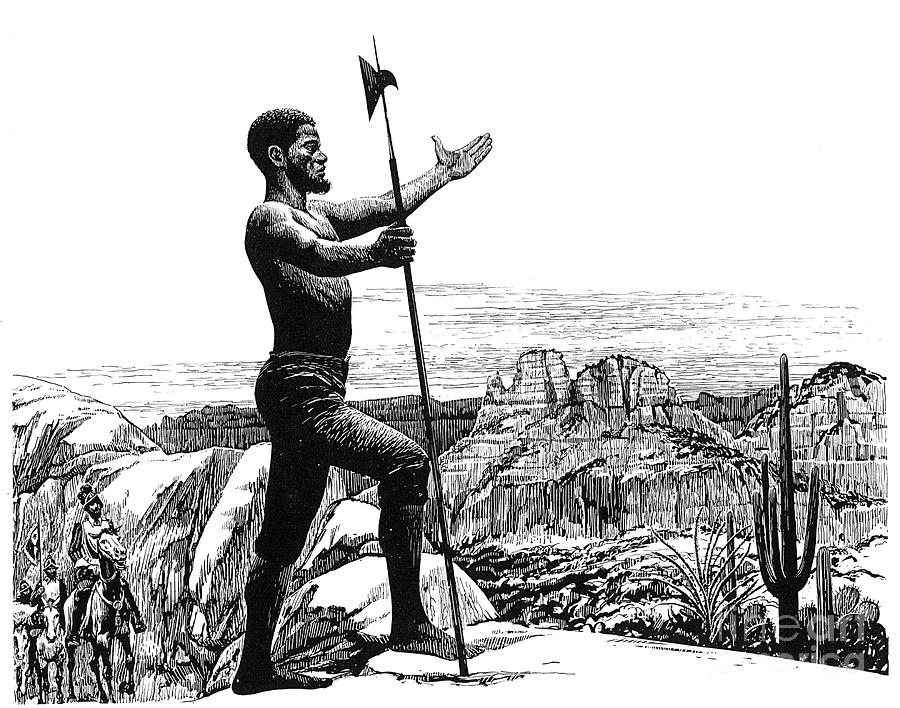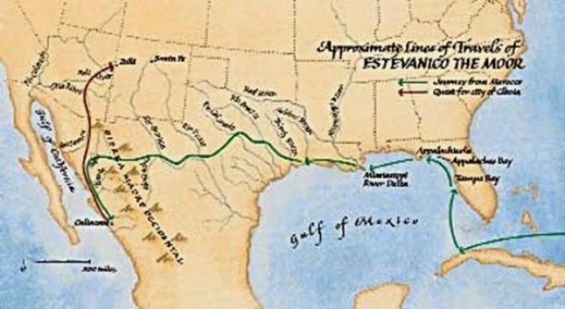Born in the coastal city on the left bank of the Oum Er-Rbia River, Mustapha did not know that he would ever cross the borders of his town called Azemmour. In 1513, the latter fell to the Portuguese, and like other inhabitants, Mustapha was captured and enslaved by the invading force. As many accounts suggest, Mustapha Zemmouri was shipped to Europe when he was sold to a Spanish nobleman called Andres Dorantes de Carranza.
It all happened in 1527, when Mustapha was given a new name and was sent alongside a group of Spanish men fpr an expedition led by Alvar Nunez Cabeza de Vaca. Estebanico the Moore travelled for 8 years with Andrés Dorantes de Carranza, and Alonso del Castillo Maldonado. Their trip to the New World was similar to the ones that we are all familiar with about the Eldorado, in books and fictitious novels.

According to an article published by HistoryNet, Estebanico was «in the service of Andrés Dorantes, commander of a company of infantry in the expedition being formed by Pánfilo de Narváez to explore and conquer the lands stretching west from Florida along the Gulf of Mexico». Looking for gold, the crew sailed all the way down to Cuba where the ships landed after suffering from a hurricane. In April 1528, the crew headed by Cabeza de Vaca finally was able to reach the western cost of Florida north of Tampa Bay which is now known as Petersburg.
An adventurous trip
Once in Florida, Estebanico alongside his master Dorantes and led by Narváez, claimed the territory in the name of King Carlos I of Spain and sent his crew to explore the land looking for gold. After three months of desperate attempts, the Spaniards suffered from various ailments: hungry, wounded and sick as they couldn’t find anything and they were fought by the natives.
On September 22nd, 1528, Estebanico sailed with his master Dorantes with another company captain namely Alonzo del Castillo Maldonado and 48 other men. Relying on a chronicle written 500 years ago by Cabeza de Vaza, exhausted by hunger, thirst and sun exposure, the men reached by the end of October the Gulf of Mexico driven by a strong current that waved their ships through the Mississippi river.

Eventually, Estebanico’s crew made it through with Dorantes after their ships shuttered. «The survivors from the raft commanded by Cabeza de Vaca, whom the local natives had fed and sheltered», HistoryNet indicates. Detained on the island for the whole winter, Estebanico, Cabeza de Vaca and Dorantes along with survivors called their adventure «Malhando» or Misfortune.
«In April 1529, Andrés Dorantes gathered the survivors of his boat, including Estévanico and Castillo, and crossed to the mainland, leaving Cabeza de Vaca and his men behind. Captured by natives considerably less friendly than those on the island, Dorantes’ party spent the next six years doing heavy labor and enduring the taunts and blows of their captors», the same source pointed out, stating that the triplet were lucky enough to survive hard labor, hunger and the natives’ arrows.
Detained in Malhando
After being separated for 6 years, Cabeza de Vaca who refused to leave the Malhando island, reunited with all of Narvaez’s expedition including Dorantes, Castillo and Estevanico.
Once reunited, the crew planned to escape the island and seek shelter at the Spanish settlement in Mexico. In September 1535, Estebanico the Moore, Castillo, Dorantes and Cabeza left Malhando. «Soon after their escape, Estévanico and the three Spaniards met men who asked to be cured of severe headaches», they got famous afterwards for being healers who possess magical powers. «They were showered with gifts–food, deer skins, cotton blankets, and valuable trinkets such as coral beads, turquoises, arrow-shaped emeralds, and a large copper rattle embossed with the figure of a human face–which they shared with their followers», their reputation grew increasingly and they were nicknamed «children of the sun».
The «treatment» having worked, others came to the strangers seeking similar cures. Fearful of what would happen should his efforts fail, Castillo surrendered the role of chief healer to Cabeza de Vaca, who soon was faced with a real challenge–a man who, seemingly, was already dead. Cabeza de Vaca prayed over the man, and as if by miracle, the man recovered. «This caused great surprise and awe,» according to Cabeza de Vaca, the equally incredulous healer, «and all over the land nothing else was spoken of.»
Estebanico through this long journey learned six native languages. A gifted and diplomatic man, the black-skinned Moroccan native was the group’s talker as he was good at dealing with natives. Traveling again, Estebanico left the coast with his master and native followers for the Pacific Ocean.
Finding the Seven cities of gold
In 1539, «Don Antonio de Mendoza, the first viceroy of New Spain, authorized a reconnaissance expedition to Cíbola under the leadership of a Franciscan priest named Marcos de Niza» who appointed Estebanico as a guide and interpreter. Starting the journey looking for the mythical Seven cities of gold, the Moore was admired by the natives who gave him fine gifts. Annoyed by that, Marcos, once the expedition reached the desert, ordered Estevanico to go ahead with a few of his men and send back word of his progress.

«He thought he could get all the reputation and honor himself,» reported Pedro de Casteñeda, chronicler of Spanish explorer Francisco Vásquez de Coronado’s later expedition, «and that if he should discover those settlements . . . he would be considered bold and courageous». However, Estevanico reached the city of Cíbola where he was mistrusted and disliked by the Zuni inhabitants.
«Unreasonable to say that the people were white in the country from which he came and that he was sent by them, he being black», Zunis captured the Moore for being an evil man who assaulted their women. Versions later contradict about the death of Esteban as can be seen with the chronicles which suggest that he escaped the Zunis and was killed by their arrows.
No one knows where Estebanico is buried nowadays but indeed he was the first Moroccan to lay a foot on the American soil. Along with his master and expedition team, he went through several adventures and misfortunes but nonetheless managed to engrave his name in history.





 chargement...
chargement...













